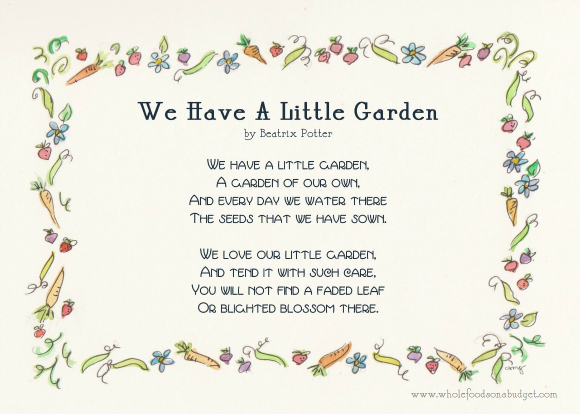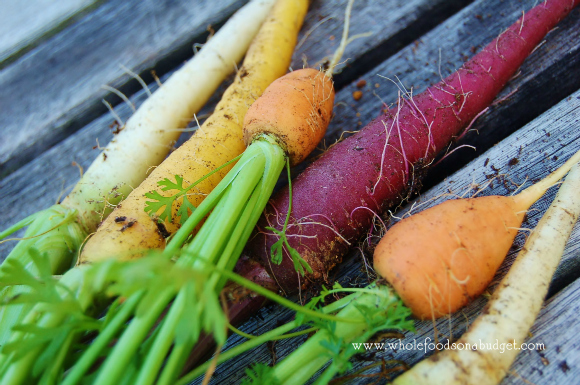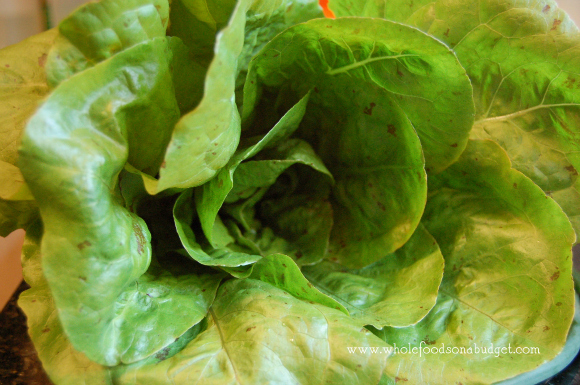
Does your child have a garden? A little space to call their own? A place for digging, planting, experimenting, watering, harvesting?
A Place to Grow
Giving your child a small patch of garden space provides a wonderful opportunity for your child to learn and grow. It’s not just about learning the science of gardening. A personal garden can give a child a sense of ownership and teach responsibility. It gives an opportunity for success and accomplishment.
He will oversee his own garden from beginning to end, he will learn patience and he will experience the joy and reward that come from anticipation and waiting. She will learn about fruits and vegetables. From where do they come? (A tiny seed? Really?!) How are they formed? How do they grow? How long does it take?
A personal garden encourages a child to explore new foods and to eat healthy, nourishing foods.
A child’s garden does not have to be very large, especially for a young child. A small square of your garden or a terracotta pot on your patio or balcony will do.Since we have a very small yard and garden, both of my older two children (ages 8 and 7) have their own 14 inch pots on our back patio in which they have gardened for the past three years.
Last year in her pot, my daughter grew lettuce, peas and carrots in the spring, followed by scarlet flax and a tomato plant in the summer. Even a single pot provides a child with room to experiment and grow multiple plants.

Guide Gently
When gardening with children, miniature varieties are often good choices. Miniature varieties typically do not need much growing space, they produce rapidly and are often prolific. Most children will enjoy harvesting lots of little items more than just a few large ones.
Some of our favorite plants have been all types of cherry and grape tomatoes, miniature melons, ground cherries, miniature cucumbers, Tom Thumb lettuce, edible flowers like nasturtiums and bright yellow mini pattypans. I can’t tell you how excited my kids were to split the first head of Tom Thumb lettuce from my daughter’s garden pot, or how much fun they had taste-testing each color of the carrots they planted!
With my kids’ gardens, I’ve focused on letting them have the final say-so as to what is planted. I want them to own it; I want them to be excited about it! That said, I do try to gently point them toward more successful ventures.
When my daughter was looking through the seed catalog at carrots, I helped her choose a type known for its reliability and sweetness. When my son wanted to grow watermelons, I pointed him to some miniature muskmelons better suited for container gardening. He found a colorful striped “tigger” melon that he is excited to grow.
But in the end, it’s their garden and I let them choose their plants.
Success and Failure
Though I want my children’s gardens to thrive, I’m content with mediocre results (and so are they!) — and I’m not afraid of failure. All failure isn’t bad.
One year my daughter wanted to plant peas. Really badly. We were a little late starting her garden pot, and so I told her she couldn’t plant peas because it was too late in the spring for them. But she pleaded with me, saying they MIGHT grow.
As I reflected a moment, I thought, Why am I trying to convince her of this? I’ve told her this is her pot and she can choose whatever she wants to plant. If the peas fail, she will learn what I meant when I told her it was too late.
And so my daughter planted her peas. Sure enough, the peas spiraled up her little trellis, flowered… and then the heat of summer hit and the vines withered and died. No peas.
Though disappointed, both she and her brother learned firsthand about the necessity of planting plants at the proper times. They spent the rest of summer explaining to friends and family why the tomatoes grew but the peas didn’t. Lesson learned!

It’s Not Too Late
Though we’re into summer, it’s not too late to start a garden. There are still seedlings at the local nurseries available for purchase, and there are fast-growing summer crops like bush beans, some lettuces, herbs and flowers that can still be planted from seed. As summer wanes, beets, peas, carrots, lettuce and spinach can be planted.
Your child will learn many lessons from her garden. It’s a wonderful opportunity for her to learn, explore and engage with the natural world around her.
My Kids’ Favorite, Easy-to-Grow Garden Plants
Spring and Fall: Baby spinach, lettuce, beets, carrots, peas.
Summer: Bushbeans, cherry or grape tomatoes, zucchini and other summer squashes, miniature cucumbers, ground cherries, marigolds, nasturtiums, johnny jump-ups.
*Keep in mind that spinach, lettuce, beets and summer squashes can be harvested small or large, so don’t be afraid of picking them small and early. Your kids will love the small size, and early picking encourages summer squashes to produce more.
Do your children have their own garden? What lessons have they learned from gardening?
Artwork and photos by Christy Greer. Poem by Beatrix Potter.
We only recommend products and services we wholeheartedly endorse. This post may contain special links through which we earn a small commission if you make a purchase (though your price is the same).


My son has helped me with all of our gardens this year, he’s enjoyed every step of it. He also has his own garden and wanted to only plant strawberries. He also gets to have fun in our rhubarb patch and randomly plants things there too. I like the idea of a large pot!
Any suggestions on what we could grow in an apartment by a window?
Shawn, lettuce is a great vegetable to grow by a window. It only needs a few hours of sunlight a day, and lettuce grows really quickly. I’d recommend leaf lettuce, which you just cut as soon as it’s big enough for your liking. Lettuce can also be grown in small containers, and for leaf lettuce you only need a few inches of soil depth, so you can reuse containers, like those plastic tubs lettuce comes in at the store, or even plastic shoebox storage containers. Herbs like basil, thyme and sage also do well by windows. Basil is very easy to grow from seed.
Great article! You’ve given me a renewed resolve to include our kiddos in the process of obtaining our food. Our eldest is almost 3, so I have so many years to enjoy this kind of relationship with my children. I love the idea of giving them their own space – especially letting them test seeds that you know will most likely not produce. I think our youth are – generally – inadequately prepared for failure. This should help. 😉 Thanks again!